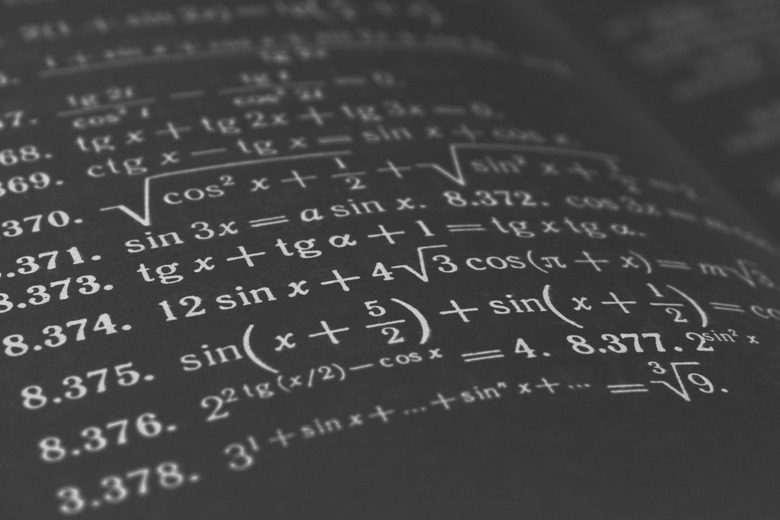How To Factor Polynomials With Fractions
The best way to factor polynomials with fractions begins with reducing the fractions to simpler terms. Polynomials represent algebraic expressions with two or more terms, more specifically, the sum of multiple terms that have different expressions of the same variable. Strategies that assist with simplifying polynomials involve factoring out the greatest common factor, followed by grouping the equation into its lowest terms. The same holds true even when solving polynomials with fractions.
Polynomials with Fractions Defined
Polynomials with
Fractions Defined
You have three ways in which to view the phrase polynomials with fractions. The first interpretation addresses polynomials with fractions for coefficients. In algebra, the coefficient is defined as the number quantity or constant found before a variable. In other words, the coefficients for 7a, b and (1/3)c are 7, 1 and (1/3) respectively. Two examples, therefore, of polynomials with fraction coefficients would be:
\(\frac{1}{4}x^2 + 6x + 20 \text{ and } x^2 + \frac{3}{4}x + \frac{1}{8}\)
The second interpretation of "polynomials with fractions" refers to polynomials existing in fraction or ratio form with a numerator and a denominator, where the numerator polynomial is divided by the denominator polynomial. For example, this second interpretation is illustrated by:
\(\frac{x^2 + 7x + 10}{x^2 + 11x + 18}\)
The third interpretation, meanwhile, relates to partial fraction decomposition, also known as partial fraction expansion. Sometimes polynomial fractions are complex so that when they are "decomposed" or "broken down" into simpler terms, they are presented as sums, differences, products, or quotients of polynomial fractions. To illustrate, the complex polynomial fraction of:
\(\frac{8x + 7}{x^2 + x – 2}\)
is evaluated through partial fraction decomposition, which, incidentally, involves factoring of polynomials, to be, in its simplest form:
\(\bigg(\frac{3}{x+2}\bigg)+\bigg(\frac{5}{x-1}\bigg)\)
Basics of Factoring – Distributive Property and FOIL Method
Basics of Factoring
–
Distributive Property and FOIL Method
Factors represent two numbers that when multiplied together equal a third number. In algebraic equations, factoring determines what two quantities were multiplied together to arrive at a given polynomial. The distributive property is heavily followed when multiplying polynomials. The distributive property essentially allows one to multiply a sum by multiplying each number individually before adding the products. Observe, for instance, how the distributive property is applied in the example of :
\(7(10x + 5) \text{ to arrive at the binomial of } 70x + 35.\)
But, if two binomials are multiplied together then an extended version of the distributive property is utilized via the FOIL method. FOIL represents the acronym for First, Outer, Inner, and Last terms being multiplied. Hence, factoring polynomials entails performing the FOIL method backwards. Take the two aforementioned examples with the polynomials containing fraction coefficients. Performing FOIL method backwards on each of them results in the factors of
\(\bigg(\frac{1}{2}x + 2\bigg)\bigg(\frac{1}{2}x + 10\bigg)\)
for the first polynomial, and the factors of
\(\bigg(x + \frac{1}{4}\bigg)\bigg(x + \frac{1}{2}\bigg)\)
for the second polynomial.
Example:
\(\frac{1}{4}x^2 + 6x + 20 = \bigg(\frac{1}{2}x + 2\bigg)\bigg(\frac{1}{2}x + 10\bigg)\)
Example:
\(x^2 + \frac{3}{4}x + \frac{1}{8} = \bigg(x + \frac{1}{4}\bigg)\bigg(x + \frac{1}{2}\bigg)\)
Steps to Take When Factoring Polynomial Fractions
Steps to Take When Factoring Polynomial
Fractions
From above, polynomial fractions involve a polynomial in the numerator divided by a polynomial in the denominator. Evaluating polynomial fractions thus necessitates factoring the numerator polynomial first followed by factoring the denominator polynomial. It helps to find the greatest common factor, or GCF, between the numerator and the denominator. Once the GCF of both the numerator and denominator is found, it cancels out, ultimately reducing the entire equation into simplified terms. Consider the original polynomial fraction example above of
\(\frac{x^2 + 7x + 10}{x^2+ 11x + 18}\)
Factoring the numerator and denominator polynomials to find the GCF results in:
\(\frac{(x + 2)(x + 5)}{(x + 2)(x + 9)}\)
with the GCF being (x + 2).
The GCF in both the numerator and the denominator cancel each other out to provide the final answer in the lowest terms of (x + 5) ÷ (x + 9).
Example:
\(\begin{aligned}
\frac{x^2 + 7x + 10}{x^2+ 11x + 18} &= \frac{\cancel{(x + 2)}(x + 5)}{\cancel{(x + 2)}(x + 9)} \
&=\frac{x + 5}{x + 9}
\end{aligned}\)
Evaluating Equations via Partial Fraction Decomposition
Evaluating Equations via Partial Fraction
Decomposition
Partial fraction decomposition, which involves factoring, is a way of rewriting complex polynomial fraction equations into simpler form. Revisiting the example from above of
\(\frac{8x + 7}{x^2 + x – 2}\)
Simplify the Denominator
Simplify the Denominator
Simplify the denominator to get:
\(\frac{8x + 7}{x^2 + x – 2} = \frac{8x + 7}{(x + 2)(x – 1)}\)
Rearrange the Numerator
Rearrange the Numerator
Next, rearrange the numerator so that it starts to have the GCFs present in the denominator, to get:
\(\begin{aligned}
\frac{8x + 7}{(x + 2)(x – 1)} &= \frac{ 3x + 5x – 3 + 10 }{(x + 2)(x – 1)} \
&= \frac{3x – 3}{(x + 2)(x – 1)} + \frac{5x + 10 }{(x + 2)(x – 1)} \
\end{aligned}\)
For the left addend, the GCF is (x – 1), while for the right addend, the GCF is (x + 2), which cancel in the numerator and denominator, as seen in:
\(\frac{3x – 3}{(x + 2)(x – 1)} + \frac{5x + 10 }{(x + 2)(x – 1)} = \frac{3\cancel{(x – 1)}}{(x + 2)\cancel{(x – 1)}} + \frac{5\cancel{(x + 2)}}{\cancel{(x + 2)}(x – 1)}\)
Thus, when the GCFs cancel, the final simplified answer is:
\(\frac{3}{x + 2} + \frac{5}{x – 1}\)
as the solution of the partial fraction decomposition.
Cite This Article
MLA
Agravante, Mariecor. "How To Factor Polynomials With Fractions" sciencing.com, https://www.sciencing.com/factor-polynomials-fractions-7548319/. 26 October 2020.
APA
Agravante, Mariecor. (2020, October 26). How To Factor Polynomials With Fractions. sciencing.com. Retrieved from https://www.sciencing.com/factor-polynomials-fractions-7548319/
Chicago
Agravante, Mariecor. How To Factor Polynomials With Fractions last modified March 24, 2022. https://www.sciencing.com/factor-polynomials-fractions-7548319/
